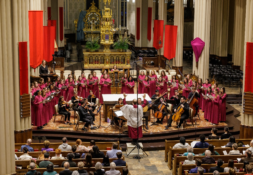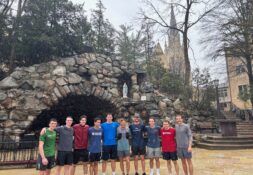Every third Thursday of September, October, and November the Snite Museum’s Third Thursday program is filled with “creative conversations, powerful performances, exciting exhibitions, and delicious delicacies,” according to the museum’s website. Mishoe Brennecke, Associate Professor of Art History at the University of the South, gave the opening lecture on the life and work of painter Mary Cassatt.
Brennecke chose to focus on Cassatt’s early career, especially the career choices she had to make as a woman in the 19th century. Through the lens of Cassatt’s paintings and the remarks of the artist’s friend Abigail May Alcott, Brennecke spent the lecture outlining the “real genius” of Cassatt’s work. She presented images of Cassatt’s paintings in the context of her artistic influences and other artists of her time.
Cassatt was born in Allegheny, Pennsylvania and at 16 enrolled in the Pennsylvania Fine Arts Academy. It was here that Cassatt began to feel the disparity in the education between men and women. For example, she was not allowed to paint live models for the sake of propriety; rather, she was forced to stick to still-life scenes. Flower-painting was seen as the limit for female painters, but Cassatt was not satisfied. Though very expensive, she and her mother traveled to Paris in 1865 to study figure-painting. After four years in Paris, she had to return home, but longed to return to Europe. The Bishop of Pittsburgh commissioned her to go to Italy as a copyist, and she jumped at the opportunity.
It was at this point, Brennecke said, that Cassatt began to gain renown for the original works she was creating. She traveled to Seville, Spain and was influenced by the painterly qualities there, a style of oil painting that has the visible and deliberate brushstrokes commonly connected to the Impressionist movement. After this, she settled permanently in Paris, but soon became frustrated by the French academic art that surrounded her.
Abigail May Alcott, younger sister of Little Women author Louisa May Alcott, was a flower painter and copyist, the typical position of any woman painter at the time. She praised Cassatt highly not only for her talent, but for the great strides she made as a female painter. In a letter to her mother in 1876, Alcott wrote that Cassatt was a “first class light,” and was “perfectly poised for a successful career.” By this time, Cassatt had enjoyed some professional success, but was not as well-known as her admirers believed she should be.
Cassatt submitted her paintings to the Paris Salon, the only way to gain recognition in the academic art circle, and was disappointed when none of her works were accepted. In 1877, fellow artist Edgar Degas invited Cassatt to join the French Impressionist exhibition, of which he was a founding member. She accepted and became the only American to participate in their exhibition; she never again submitted to the Paris Salon.
Brennecke aligns this decision alongside the rest as one of the boldest of Cassatt’s career moves, and it defined the subject matter and form of her paintings. The Impressionists believed that the modern world was an appropriate and beautiful subject for art, which can be seen through Cassatt’s representation of women in all aspects of life, both in and out of the home. She painted with vibrant colors, often pastels, and imbued her female subjects with energy and heroism.
“This empowering vision of women stemmed from her own confidence,” Brennecke said. Cassatt had the advantages of education and financial prosperity, as well as talent and a fierce determination to succeed. She wished to convey this feminine strength and passion through her paintings of the public and domestic lives of women. Cassatt had a deep respect for all of her subjects, and all the varying work of women.
She was, as Brennecke remarked, “a modern painter of modern women.”
The last two lectures in the Third Thursday program are on October 18, entitled “Breaking the Mold: Musical Reflections by the South Bend Symphony,” and on November 15, entitled “Princess Marie Gets a Face Lift.” Light refreshments follow all lectures and performances.
Liz Everett is a junior PLS and English major from McGlinn Hall. Contact her at eeveret1@nd.edu.





